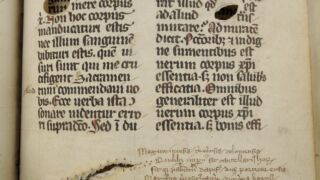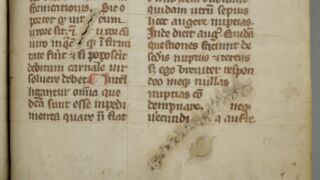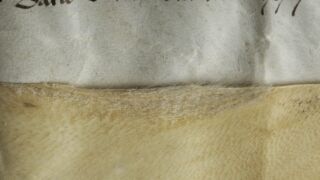A 2.2. Hair remains
A 2 damage subcategories:
A 2.1. Holes
A 2.2. Hair remains
A 2.3. Striations
A 2.4. Traces of jagged action
A 2.5. Veining, vein evidence, drainage of blood vessels
A 2.6. Variation in thickness
A 2.7. Opacity, transparency
A 2.8. Splitting
A 2.9. Variation in colour or surface appearance, matte, semi-matte, glossy
A 2.10. Presence of grain layer
The unremoved hairs the remain after the parchment is produced.
The animal’s coat along with the epidermis that may not have been removed as the result of the uneven mechanical processing of the raw skins.

Ürik TLA.230.1.cm4, 13. saj.
Eemaldamata karvkude.
Pärgamendi valmistamisel eemaldamata jäänud karvkude.
Toornahkade ebaühtlase mehaanilise töötlemise tulemusena võis õhemates kohtades ja rebendite siseservades jääda karvkude koos epidermisega eemaldamata.
Unremoved hair tissue during the making of parchment.
As a result of uneven mechanical processing of raw hides, the hair tissue together with the epidermis could remain unremoved in thinner places and on the inner edges of tears.

Ürik TLA.230.1.cm4, 13. saj.
Eemaldamata karvkude.
Pärgamendi valmistamisel eemaldamata jäänud karvad.
Pärgamendi õhendamisel tekkinud aukude siseservades võis jääda karvkude koos epidermisega eemaldamata.
Unremoved hairs when making parchment.
At the inner edges of the holes created by thinning the parchment, the hair tissue together with the epidermis may have remained unremoved.

Ürik TLA.230.1-i.825, 1489. a.
Eemaldamata karvkude.
Pärgamendi valmistamisel eemaldamata jäänud karvad. Toornahkade ebaühtlase mehaanilise töötlemise tulemusena võis õhemates kohtades ja naha servades jääda karvkate koos epidermisega eemaldamata.
Tugt degradeerunud jäsemeala koos eemaldamata karvkoega.
Unremoved hairs when making parchment. As a result of the uneven mechanical processing of the raw hides, the fur along with the epidermis could remain unremoved in thinner places and at the edges of the skin.
Severely degraded limb area with unremoved fur.
